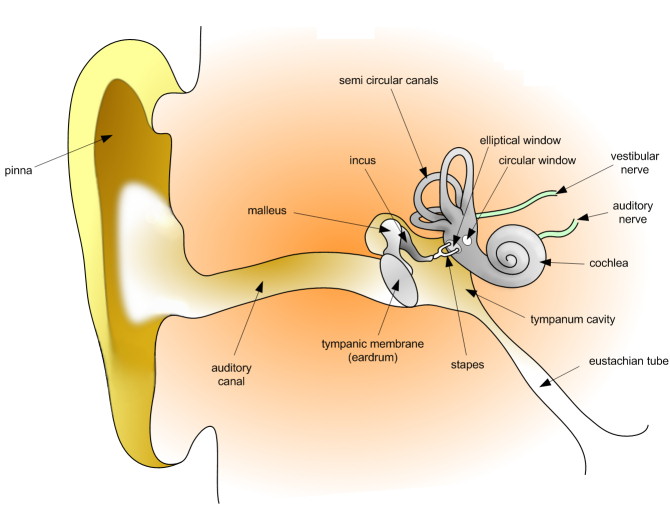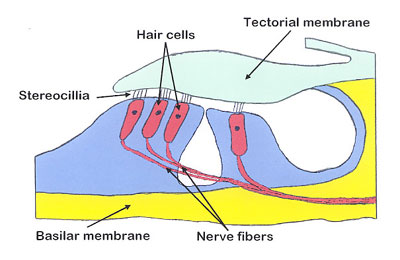There is an infinite number of topics that can be extracted from the Human Body. One can never start to even begin to describe any part of it in a finite sense of detail. It simply is an endless well of constant fascination. However, one has to start somewhere.
Do you ever wonder how you actually manage to hear things? If you do, and you would like to know how that process happens in a concise fashion using mostly non-complicated terminology, keep reading.
The Human sense of hearing is a complex process that involves physical parts and electronic apparatus that all work in a synergistic fashion to ultimately stimulate the proper nervous cells in the Cerebral cortex (i.e. the brain) to produce the sense of hearing.

It all starts in our external ear. The external ear carries the function of a large dish that can maximize the amount of sound waves received and funneled into the external ear canal. The external ear canal is the part of the ear that you clean from produced wax, and is largely empty space that solely functions as a funnel for sound waves to the middle ear. At the end of this canal we come to what is called the tympanic membrane which most recognize as the ear drum. It's just like a membrane on a regular drum, except much finer, and attached to a set of bones that move in accordance to the vibration of that membrane.
The bones that are within the middle ear, are the smallest bones in the human body, and are exquisite in nature. They conduct sound waves by motion to the the inner ear, through a small hole with a membrane called the elliptical window. The mechanical vibrations end up pressuring the elliptical window of the inner ear.
Now the simplistic part is done, here comes the more fascinating part of this little story. How does the inner ear actually converts what used to be sound waves, into electrical signals?
Musicians might love to know more about this part of the ear. Within the inner ear is a tremendously intricate structure. It really is a musical instrument. The inner ear is to, put it simply a fine series of tubes. There are two main functions to it, the first is to convert sound into electric signals that can be understood by the human brain, and the second is to give the person a sense of position and aid in balance.
So how does such a small organ achieve such tremendous objectives? Within the series of tubes is a very small membrane called the Tectorial membrane. This membrane is floating within a very special liquid called the endolymph. This fluid contains strictly balanced concentrations of certain electrolytes, which is critical to the process of eliciting electric signals from specialized cells. If the balance of electrolytes is even slightly adjusted it could completely interrupts the entire process.
of electrolytes is even slightly adjusted it could completely interrupts the entire process.
Another membrane is located within the same series of tubes called the Basilar membrane. This one is lined with cells that have specialized fine hairs we call cilia, that brush gently on the lower surface of the Tectorial membrane. The Basilar membrane is narrow and stiff at the root, thinner and compliant at the tip. As the pressure runs through the convoluted tube, the Basilar membrane starts to vibrate depending on the quality of that wave. If the wave was of high frequency, then as it reverberates through the tube, it will cause that part of the Basilar membrane that matches its frequency to vibrate. It literally is a musical instrument, where the pressure wave acts like the human finger trying to reach to that note that best matches it on the piano key that is the cell attached to the Basilar membrane.
Now, as the Basilar membrane vibrates at region corresponding to the frequency of the transmitted wave, the speciallized hair cells at that particular area start to get their hairs bend against the Tectorial membrane. When the hairs bend, special channels on that hair cell open, which culminates into an electrical impulse to be generated on that particular cell. It is then sent through a specialized nerve to the brain stem, and eventually ascends to the cerebral cortex. Each hair cell is ultimately connected to a specific area in the cerebral cortex that corresponds to its frequency. If that part of the brain is stimulated, the person "senses" that sound based on which sort of cells were stimulated in the process.
Enjoy this video which displays the entire process in a neat 3D animation:
That is, in a nutshell how the process of Human hearing occurs in the simplest of terms I could possibly think of.
P.S. I have restored the older articles I wrote that were deleted on my blog. I will miss the comments on them though. Feel free to comment on my blog, but the comments will be moderated because I wish to refer family, friends and colleagues to it. Try to be cordial and stay on topic on the blog. It goes without saying that you are free to say whatever you want on shoutwire though. Also please notify me to any mistakes I commit.
Additionally, feel free to send in any medical questions you have that you like to see answered in a weekly editorial, where I will pick 5 questions, and will try to answer them to the best of my knowledge, in simple terms and will cite sources in the process. Send them to: medfreaky@gmail.com
Do you ever wonder how you actually manage to hear things? If you do, and you would like to know how that process happens in a concise fashion using mostly non-complicated terminology, keep reading.
The Human sense of hearing is a complex process that involves physical parts and electronic apparatus that all work in a synergistic fashion to ultimately stimulate the proper nervous cells in the Cerebral cortex (i.e. the brain) to produce the sense of hearing.

It all starts in our external ear. The external ear carries the function of a large dish that can maximize the amount of sound waves received and funneled into the external ear canal. The external ear canal is the part of the ear that you clean from produced wax, and is largely empty space that solely functions as a funnel for sound waves to the middle ear. At the end of this canal we come to what is called the tympanic membrane which most recognize as the ear drum. It's just like a membrane on a regular drum, except much finer, and attached to a set of bones that move in accordance to the vibration of that membrane.
The bones that are within the middle ear, are the smallest bones in the human body, and are exquisite in nature. They conduct sound waves by motion to the the inner ear, through a small hole with a membrane called the elliptical window. The mechanical vibrations end up pressuring the elliptical window of the inner ear.
Now the simplistic part is done, here comes the more fascinating part of this little story. How does the inner ear actually converts what used to be sound waves, into electrical signals?
Musicians might love to know more about this part of the ear. Within the inner ear is a tremendously intricate structure. It really is a musical instrument. The inner ear is to, put it simply a fine series of tubes. There are two main functions to it, the first is to convert sound into electric signals that can be understood by the human brain, and the second is to give the person a sense of position and aid in balance.
So how does such a small organ achieve such tremendous objectives? Within the series of tubes is a very small membrane called the Tectorial membrane. This membrane is floating within a very special liquid called the endolymph. This fluid contains strictly balanced concentrations of certain electrolytes, which is critical to the process of eliciting electric signals from specialized cells. If the balance
 of electrolytes is even slightly adjusted it could completely interrupts the entire process.
of electrolytes is even slightly adjusted it could completely interrupts the entire process.Another membrane is located within the same series of tubes called the Basilar membrane. This one is lined with cells that have specialized fine hairs we call cilia, that brush gently on the lower surface of the Tectorial membrane. The Basilar membrane is narrow and stiff at the root, thinner and compliant at the tip. As the pressure runs through the convoluted tube, the Basilar membrane starts to vibrate depending on the quality of that wave. If the wave was of high frequency, then as it reverberates through the tube, it will cause that part of the Basilar membrane that matches its frequency to vibrate. It literally is a musical instrument, where the pressure wave acts like the human finger trying to reach to that note that best matches it on the piano key that is the cell attached to the Basilar membrane.
Now, as the Basilar membrane vibrates at region corresponding to the frequency of the transmitted wave, the speciallized hair cells at that particular area start to get their hairs bend against the Tectorial membrane. When the hairs bend, special channels on that hair cell open, which culminates into an electrical impulse to be generated on that particular cell. It is then sent through a specialized nerve to the brain stem, and eventually ascends to the cerebral cortex. Each hair cell is ultimately connected to a specific area in the cerebral cortex that corresponds to its frequency. If that part of the brain is stimulated, the person "senses" that sound based on which sort of cells were stimulated in the process.
Enjoy this video which displays the entire process in a neat 3D animation:
That is, in a nutshell how the process of Human hearing occurs in the simplest of terms I could possibly think of.
P.S. I have restored the older articles I wrote that were deleted on my blog. I will miss the comments on them though. Feel free to comment on my blog, but the comments will be moderated because I wish to refer family, friends and colleagues to it. Try to be cordial and stay on topic on the blog. It goes without saying that you are free to say whatever you want on shoutwire though. Also please notify me to any mistakes I commit.
Additionally, feel free to send in any medical questions you have that you like to see answered in a weekly editorial, where I will pick 5 questions, and will try to answer them to the best of my knowledge, in simple terms and will cite sources in the process. Send them to: medfreaky@gmail.com
